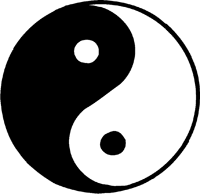Taiji or Taichi
 Taiji, also known as Taichi, is an important ancient concept in Chinese culture. The figure on the left is called Taiji Tu (Taiji figure), used to demonstrate the idea of Taiji.
Taiji, also known as Taichi, is an important ancient concept in Chinese culture. The figure on the left is called Taiji Tu (Taiji figure), used to demonstrate the idea of Taiji.
Basically Taiji is a concept to illustrate the evolving process of the universe itself and everthing in the universe from Wuji (origin) to Taiji. Or it is the ultimate Dao (truth or principle), which includes Yin/Yang and all other principles and things. Taiji involves Yin/Yang (Liangyi), then evolves to Sixiang (from Liangyi), then Bagua (from Sixiang) -- another important Chinese ancient idea.
The circle of the Taiji picture represents one, universe or Wuji. The black and white part indicate Yin and Yang (or Earth and Heaven), respectively. The curve boundary between the black and white represents everything or the human world between Yin and Yang (or Earth and Heaven), and the curve stands for change and interaction. The white dot in the black part shows some Yang exists in Yin and the black dot in the white part shows Yang contains some Yin. Thus Yin and Yang are not mutually exclusive and static. They are constantly evolving or changing to create the colorful universe.
The Taiji concept is first from Yi Jīng (or I Ching) -- a Chinese classic. Taiji (Yin/Yang) has been rooted in many aspects of people's daily life, such as Taiji Quan (shadowboxing) and Chinese medicine.


 Sterling Silver Pendant, Bangle, Bracelet
Sterling Silver Pendant, Bangle, Bracelet